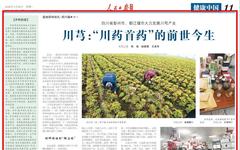 Click the above “Public Account” to subscribe!
Click the above “Public Account” to subscribe!
Source|People’s Daily Overseas Edition
Text|Xiong Jian, Zhao Xiaoxia, Wang Meihua
On March 25, the first article of the “Tour of Authentic Medicinal Materials” column published by the People’s Daily Overseas Edition focused on the authentic medicinal material of Sichuan—Chuan Xiong: “The Premier Medicinal Herb of Sichuan”. The full text is as follows:
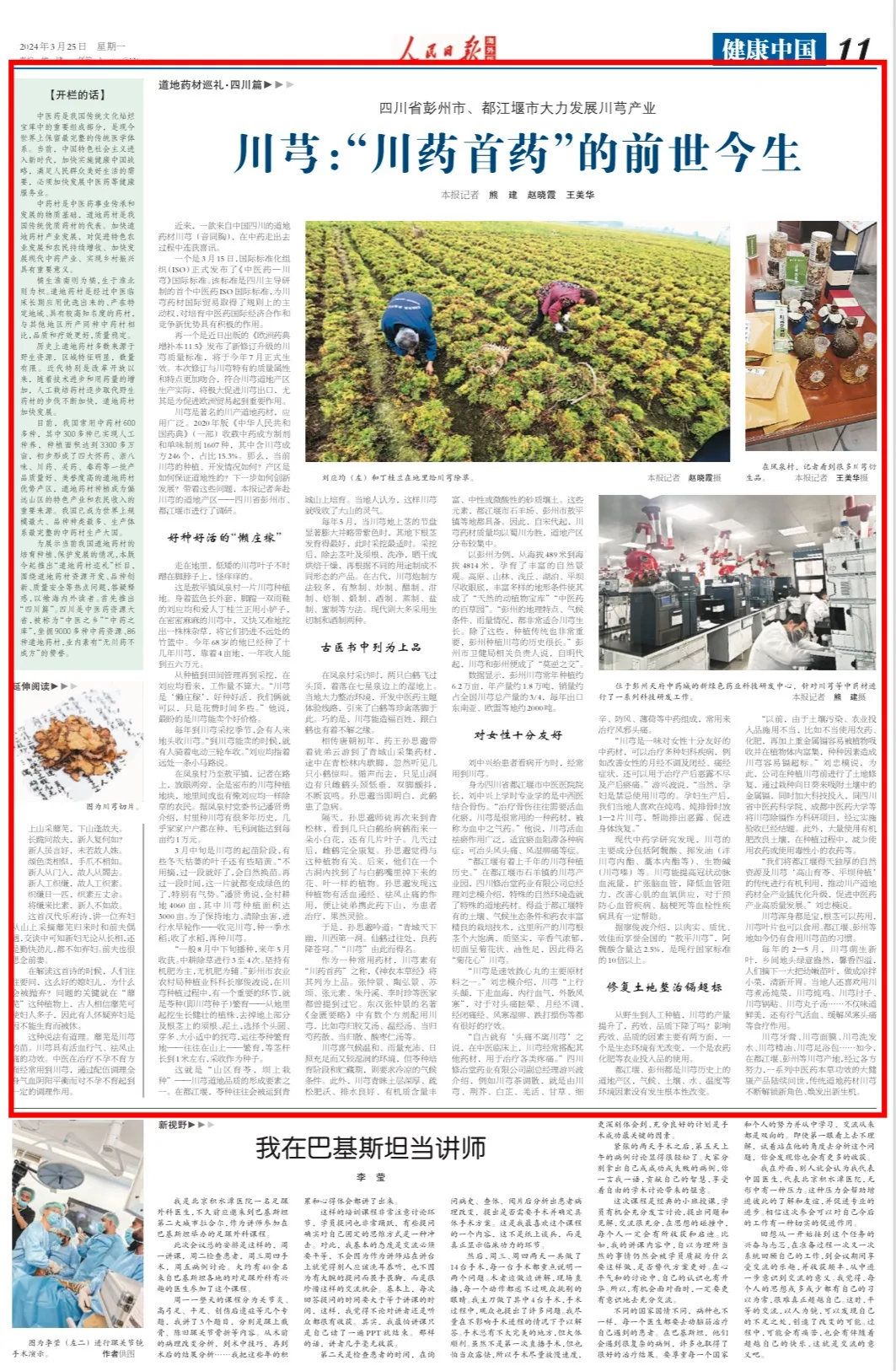
【Opening Remarks】
Traditional Chinese Medicine (TCM) is an important component of our country’s rich cultural heritage and is the most complete traditional medical system still preserved in the world today. Currently, as socialism with Chinese characteristics enters a new era, accelerating the implementation of the Healthy China strategy to meet the people’s needs for a better life requires the rapid development of health services, including TCM.
Chinese medicinal materials are the material foundation for the inheritance and development of TCM, and authentic medicinal materials represent the high-quality medicinal materials of our country. Accelerating the development of the authentic medicinal material industry is of great significance for promoting the development of characteristic agriculture, increasing farmers’ income, accelerating the development of the modern Chinese medicine industry, and achieving rural revitalization.
“Oranges grown in the south of the Huai River are oranges, while those grown in the north are trifoliate oranges.” Authentic medicinal materials are those that have been selected through long-term clinical application in TCM, produced in specific regions, and have high recognition. Compared to the same medicinal materials produced in other regions, they have better quality and efficacy, and stable quality.
Historically, most authentic medicinal materials came from wild resources, with distinct regional characteristics and limited quantities. In modern times, especially since the reform and opening up, with technological advancements and increased demand for medicinal materials, the pace of artificial cultivation of medicinal materials has gradually replaced wild medicinal materials, leading to the rapid development of authentic medicinal materials.
Currently, there are over 600 commonly used Chinese medicinal materials in our country, of which more than 300 have been successfully cultivated, with a planting area exceeding 33 million mu. A preliminary formation of several advantageous production areas for authentic medicinal materials, such as the Four Great Huai Medicines, Zhejiang Eight Flavors, Sichuan Medicines, Guan Medicines, and Qin Medicines, has been established. The cultivation of authentic medicinal materials has become a characteristic industry in remote mountainous areas and an important source of income for farmers. Our country has become the world’s largest producer of Chinese medicinal materials, with the most varieties and the most complete production system.
To showcase the current situation of the cultivation, planting, and protection of authentic medicinal materials in our country, this column will launch the “Tour of Authentic Medicinal Materials” series, focusing on hot issues such as resource development, variety innovation, and quality safety of authentic medicinal materials, to answer questions for readers at home and abroad. The first installment features “Sichuan.” Sichuan is a major province for TCM resources, known as the “Hometown of TCM” and “Treasury of Chinese Medicines,” boasting over 9,000 types of medicinal resources and 86 types of authentic medicinal materials, earning the industry praise of “No prescription is complete without Sichuan medicines.”

Recently, a type of authentic medicinal material from Sichuan, Chuan Xiong (pronounced “xiōng”), has received good news in the process of TCM going global.
One piece of news is that on March 15, the International Organization for Standardization (ISO) officially released the international standard for “Traditional Chinese Medicine—Chuan Xiong.” This standard is the first ISO international standard for TCM led by Sichuan, which has gained a proactive position in the international trade of Chuan Xiong medicinal materials and plays a positive role in cultivating new advantages for international economic cooperation and competition in TCM.
Another piece of news is that the recently published “European Pharmacopoeia Supplement 11.5” has released a newly revised and upgraded quality standard for Chuan Xiong, which will officially take effect in July this year. This revision aligns more closely with the unique quality attributes and characteristics of Chuan Xiong, conforms to the production realities of the authentic production area, and will greatly promote the export of Chuan Xiong, especially playing an important role in facilitating trade with Europe.
Chuan Xiong is a well-known authentic medicinal material produced in Sichuan, widely used. The 2020 edition of the “Pharmacopoeia of the People’s Republic of China” (Part 1) includes 1,607 Chinese medicinal formulations and single herb preparations, among which Chuan Xiong is included in 246 formulations, accounting for 15.3%. So, what is the current situation of Chuan Xiong’s cultivation and development? How do the production areas ensure authenticity? What are the next steps for innovation and development? With these questions in mind, our reporter traveled to the authentic production areas of Chuan Xiong—Pengzhou City and Dujiangyan City in Sichuan for research.
“Lazy Crop” That Grows Well
Walking in the fields, the low Chuan Xiong leaves occasionally brush against my ankles, which feels quite itchy.
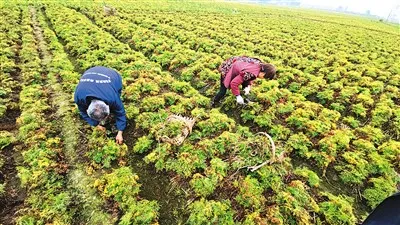
Liu Yingjun (left) and Ding Guilan are weeding Chuan Xiong in the field. Photo by Zhao Xiaoxia
This is a Chuan Xiong planting area in Fengquan Village, Aoping Town. Liu Yingjun, dressed in a blue long coat and wearing rain boots, and his wife Ding Guilan are using small shovels to quickly and accurately dig out the weeds among the dense Chuan Xiong plants, tossing them into a nearby bamboo basket. At 68 years old, he has been growing Chuan Xiong for over ten years, and with 4 mu of land, he can earn an annual income of 50,000 to 60,000 yuan.
From planting to field management to harvesting, Liu Yingjun believes the workload is not heavy. “Chuan Xiong is a ‘lazy crop,’ easy to grow and manage. Just the two of us can handle it, it just takes more time,” he said, adding that he hopes for a good price for Chuan Xiong.
Every year during the Chuan Xiong harvesting season, people come to the fields to buy Chuan Xiong. “When it’s time to sell Chuan Xiong, people come riding electric tricycles to collect it,” Liu Yingjun pointed to a small road in the distance.
In Fengquan Village and Aoping Town, the reporter observed that the fields on both sides of the road are filled with dense Chuan Xiong planting areas, with farmers weeding just like Liu Yingjun. According to Pan Xianyong, the village party secretary, the village has a long history of growing Chuan Xiong, with almost every household participating, and the gross profit can reach about 10,000 yuan per mu.
Mid-March is the seedling stage for Chuan Xiong, and some of the winter-wilted leaves are still a bit yellow. “No need to pick them; they will be fine after a while. They will naturally change to new leaves. After some time, this area will all turn green, which is quite impressive,” Pan Xianyong said. The village has a total of 4,060 mu of arable land, of which 3,000 mu is planted with Chuan Xiong. To maintain soil fertility and eliminate pests, they practice crop rotation—after harvesting Chuan Xiong, they plant a season of rice; after harvesting rice, they plant Chuan Xiong again.
“Generally, we sow in mid to late August and harvest in May of the following year. We perform tillage and weeding 3 to 4 times. We insist on using organic fertilizers primarily, with inorganic fertilizers as a supplement,” said Liao Junbo, head of the planting department of the Pengzhou Agricultural and Rural Bureau. An important step in the cultivation of Chuan Xiong is the breeding of the seeds (i.e., Chuan Xiong seeds)—digging out robust plants from the field, removing the above-ground parts and the fibrous roots and soil, selecting round, multi-bud, and appropriately sized Chuan Xiong, and transporting them to the seed breeding area—often on the mountains—for breeding until the stems grow to about 1 meter, at which point they are harvested as seeds.
This is the “mountain breeding seeds, plain planting”—one of the factors contributing to the authentic quality of Chuan Xiong. In Dujiangyan, the seeds are often transported to Qingcheng Mountain for cultivation. Locals believe that this way, Chuan Xiong absorbs the essence of the mountains.
Every May, when the nodes of the Chuan Xiong stems significantly swell and take on a slight purple hue, the underground rhizomes develop best, making this the optimal time for harvesting. After harvesting, the stems and leaves are removed, cleaned, dried, or baked, and then processed into different forms based on their intended use. In ancient times, there were many methods for processing Chuan Xiong, including decocting, frying, vinegar processing, soaking, baking, calcining, wine processing, steaming, salting, and honey processing. In modern times, most are processed by fresh cutting and wine processing.
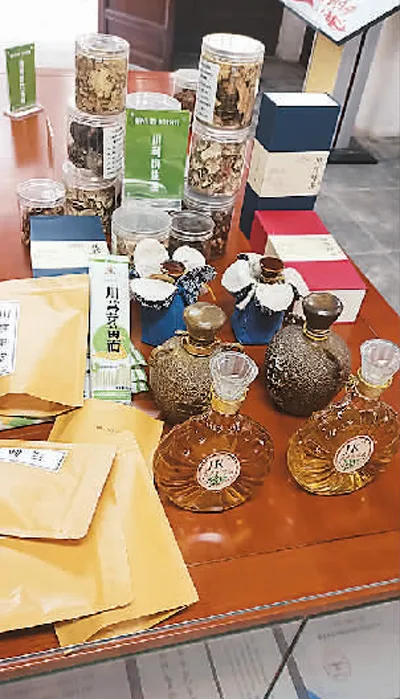
In Fengquan Village, the reporter saw many derivative products of Chuan Xiong. Photo by Wang MeihuaListed as a Superior Product in Ancient Medical Texts
During the interview in Fengquan Village, two white cranes flew overhead and landed in the wetland by Qixing Spring. The local area is actively improving the environment and developing TCM-themed experience routes, attracting rare birds like white cranes to settle here. Coincidentally, Chuan Xiong benefits the people and has an inseparable connection with white cranes.
According to legend, in the early Tang Dynasty, the Medicine King Sun Simiao traveled with his disciples to Qingcheng Mountain to collect medicinal materials. On the way, they rested in a pine forest and suddenly heard the cries of several young cranes. Following the sound, they found a female crane with its head and neck drooping, trembling on its feet, and constantly mourning. Sun Simiao immediately understood that the crane was suffering from a serious illness.
The next day, Sun Simiao and his disciples returned to the pine forest and saw several white cranes bringing a small white flower and a few leaves to the sick crane. A few days later, the female crane fully recovered. Sun Simiao believed this plant was related to the recovery. Later, they found a plant in an ancient cave that resembled the flower and leaves dropped by the white crane. Sun Simiao discovered that this plant had the effect of invigorating blood circulation, regulating menstruation, and relieving pain, so he instructed his disciples to take this medicine down the mountain for treatment, which proved to be effective.
Thus, Sun Simiao composed the verse: “Qingcheng is the most secluded in the world, the first cave in western Sichuan. Where the immortal cranes pass, good medicine descends from the heavens.” Hence, “Chuan Xiong” got its name.
As a commonly used medicinal material, Chuan Xiong is known as the “Premier Medicinal Herb of Sichuan.” The “Shennong Bencao Jing” lists it as a superior product. Renowned physicians such as Zhang Zhongjing, Tao Hongjing, Su Song, Zhang Yunsu, Zhu Danxi, and Li Shizhen have all mentioned it. In the famous work “Jinkui Yaolue” by Zhang Zhongjing of the Eastern Han Dynasty, several formulas include Chuan Xiong, such as Xiong Gui Jiao Ai Decoction, Warming Meridians Decoction, Dang Gui Shao Yao San, Dang Gui San, and Suan Zao Ren Decoction.
Chuan Xiong prefers a mild climate, abundant rainfall, sufficient sunlight, and a relatively humid environment, but during the seed breeding stage and storage period, it requires cool climate conditions. Additionally, Chuan Xiong favors deep, loose, fertile, well-drained sandy loam with rich organic matter and neutral or slightly acidic properties. These elements are present in places like Shiyangchang in Dujiangyan City and Aoping Town in Pengzhou. Therefore, since the Song Dynasty, the quality of Chuan Xiong medicinal materials has been superior in Shuchuan, with a concentrated distribution of authentic production areas.
Taking Pengzhou as an example, the elevation ranges from 489 meters to 4,814 meters, creating a rich natural landscape. The diverse terrain, including plateaus, forests, gentle hills, lakes, and plains, makes it a “natural treasure trove of flora and fauna” and a “herb garden of TCM.” “The geographical features, climate conditions, and rainfall in Pengzhou are very suitable for the growth of Chuan Xiong. Besides these, the cultivation tradition is also very important; Pengzhou has a long history of growing Chuan Xiong,” said a relevant official from the Pengzhou Health Bureau. Since the Ming Dynasty, Chuan Xiong and Pengzhou have become “inseparable friends.”
Data shows that Pengzhou has about 62,000 mu of Chuan Xiong planted annually, with an annual output of about 18,000 tons, accounting for approximately three-quarters of the total national output of Chuan Xiong, exporting about 2,000 tons annually to Southeast Asia, the European Union, and other regions.
Very Friendly to Women
Liu Zhongxing often uses Chuan Xiong when treating patients.
As the director of the Dujiangyan TCM Hospital in Sichuan Province, Liu Zhongxing studied integrated Chinese and Western medicine for bone injuries. “Treating bone injuries often requires invigorating blood circulation and removing blood stasis, and Chuan Xiong is a commonly used medicinal material, known as the ‘blood-invigorating herb.'” He said that Chuan Xiong has a wide range of effects in promoting blood circulation and removing stasis, suitable for various conditions of blood stasis obstruction; it can treat headaches, rheumatic pain, and other symptoms.
“Dujiangyan has a history of growing Chuan Xiong for over a thousand years.” In the Chuan Xiong Industrial Park in Shiyang Town, Dujiangyan City, Liu Zhongmo, general manager of Sichuan Xiuzhitang Pharmaceutical Co., Ltd., explained that the unique natural environment has created special authentic medicinal materials. Thanks to the unique soil, climate, and ecological conditions of Dujiangyan, along with the rich and skilled cultivation techniques of local farmers, the Chuan Xiong roots produced here are large, plump, firm, aromatic, and have a chrysanthemum-like cross-section, hence the name “Chrysanthemum Heart” Chuan Xiong.
“Chuan Xiong is one of the main raw materials for the Quick-Acting Heart Rescue Pill.” Liu Zhongmo explained that Chuan Xiong “ascends to the head, descends to the blood sea, circulates blood and qi internally, and disperses wind and cold externally,” making it effective for headaches, dizziness, menstrual irregularities, dysmenorrhea, wind-cold dampness, and injuries.
“Since ancient times, there has been a saying that ‘headaches are inseparable from Chuan Xiong.’ In clinical practice, Chuan Xiong is often combined with other medicinal materials to treat various pains,” said You Xingbo, deputy general manager of Sichuan Xiuzhitang Pharmaceutical Co., Ltd. For example, Chuan Xiong Tea Tiao San is composed of Chuan Xiong, Jing Jie, Bai Zhi, Qiang Huo, Gan Cao, Xi Xin, Fang Feng, and Bo He, commonly used to treat headaches caused by wind pathogens.
“Chuan Xiong is a very friendly medicinal material for women, capable of treating various gynecological diseases, such as improving menstrual irregularities and dysmenorrhea, and can also be used to treat postpartum lochia and postpartum pain.” You Xingbo said, “Of course, pregnant women are advised against using Chuan Xiong. After childbirth, local people like to add 1-2 slices of Chuan Xiong when stewing chicken or pork ribs to help expel lochia and promote recovery.”
Modern TCM research has found that the main components of Chuan Xiong include ferulic acid, volatile oils (ligustilide, butylidenephthalide, etc.), and alkaloids (chuanxiongzine). Chuan Xiong can increase coronary blood flow, dilate cerebral blood vessels, reduce vascular resistance, and improve myocardial oxygen supply, which is helpful in preventing cardiovascular diseases and thrombotic diseases such as cerebral infarction.
According to Liao Junbo, the “Aoping Chuan Xiong,” known for its fleshy, high-quality, and effective properties, has a ferulic acid content of 2.5%, which is more than ten times the current national standard.
Restoring Land and Treating Cadmium Exceedance
From wild to artificial cultivation, has the yield of Chuan Xiong increased, and has its efficacy and quality declined? The factors affecting efficacy and quality mainly include two aspects: whether the ecological environment has changed and the use of agricultural inputs such as pesticides and fertilizers.
Dujiangyan and Pengzhou are both historical authentic production areas for Chuan Xiong, and the climate, soil, water, and temperature conditions have not fundamentally changed.
“In the past, due to soil pollution and improper use of agricultural inputs, such as improper use of pesticides and fertilizers, combined with the fact that heavy metal cadmium is easily absorbed by plants and accumulates in plant bodies, various factors have caused Chuan Xiong to easily exceed cadmium limits,” Liu Zhongmo said. To address this, the company conducted land restoration before planting Chuan Xiong by planting sunflowers to absorb cadmium from the soil. At the same time, they increased technological investment, collaborating with the Sichuan Academy of Traditional Chinese Medicine and Chengdu University of Traditional Chinese Medicine to treat cadmium in Chuan Xiong as a research project, which has been completed and accepted. Additionally, they have significantly increased the use of organic fertilizers to improve the soil and reduced the use of pesticides or used less toxic pesticides during the planting process.
“We will organically utilize Dujiangyan’s unique natural resources and the traditional practice of ‘high mountain breeding seeds, plain planting’ to promote the optimization and upgrading of the entire industrial chain of authentic medicinal materials from Sichuan, facilitating the high-quality development of the TCM industry,” Liu Zhongmo said.
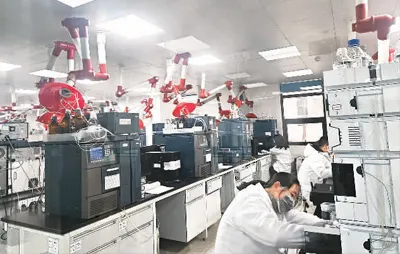
Located in the new green pharmaceutical technology research and development center in Tianfu Traditional Chinese Medicine City, a series of technological research and development work is being carried out on Chuan Xiong and other medicinal materials. Photo by Xiong Jian
Chuan Xiong is a treasure; its rhizomes can be used medicinally, and its leaves can also be consumed. In places like Dujiangyan and Pengzhou, there is still a habit of eating Chuan Xiong seedlings.
Every year from February to May, when Chuan Xiong sprouts new leaves, the countryside is lush and fragrant. People pick a large handful of tender seedlings and leaves to make cold dishes, which are refreshing and appetizing. Locals also enjoy using Chuan Xiong to make soups and stews, such as Chuan Xiong stewed chicken, Chuan Xiong pork knuckle, Chuan Xiong pot stickers, and Chuan Xiong meatball soup… not only are they delicious, but they also have therapeutic effects of promoting qi and blood circulation and alleviating wind-cold headaches.
Chuan Xiong toothpaste, Chuan Xiong facial masks, Chuan Xiong shampoos, Chuan Xiong essential oils, Chuan Xiong foot bath bags… Nowadays, in the production areas of Chuan Xiong such as Dujiangyan and Pengzhou, through various efforts, a series of health products based on the medicinal properties of TCM are being launched, continuously unlocking new roles for the traditional authentic medicinal material Chuan Xiong and revitalizing it.
 Further Reading
Further Reading
The image shows slices of Chuan Xiong.
“Climbing the mountain to pick the herb, encountering an old husband on the way down.”
“Kneeling to ask the old husband, how is the new wife?”
“The new wife says she is good, but not as good as the old one.”
“The colors may be similar, but the hands and claws are not.”
“The new wife enters the door, while the old one leaves through the side.”
“The new wife weaves silk, while the old one weaves plain fabric.”
“The new wife weaves one bolt of silk a day, while the old one weaves over five zhang.”
“Comparing silk to plain fabric, the new wife is not as good as the old one.”
This Han Dynasty Yuefu poem tells the story of a discarded wife who encounters her ex-husband while picking herbs on the mountain. Through their conversation, it becomes clear that the new wife, whether in appearance or diligence, cannot compare to the discarded wife. The ex-husband also misses his former wife.
When interpreting this poem, people often ask why such a good wife was abandoned. The key issue lies in the plant “mǐwú,” which the ancients believed could help women bear children, leading some to suspect that the discarded wife was abandoned due to infertility.
This interpretation has merit. Mǐwú is the seedling of Chuan Xiong. Chuan Xiong has the effects of invigorating blood circulation, promoting qi, and relieving pain. TCM often uses Chuan Xiong in treating infertility by adjusting the balance of qi, blood, yin, and yang throughout the body.
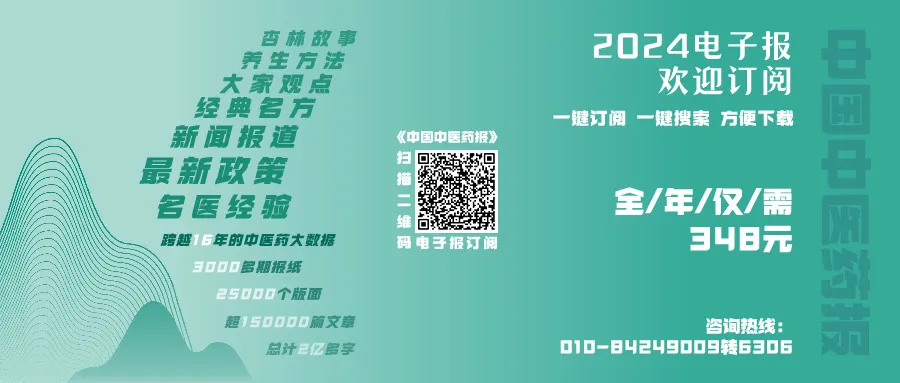
(Click the image to subscribe to the newspaper)


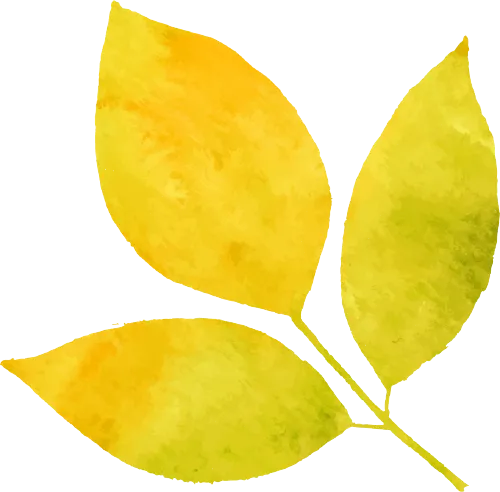 (Enter the micro-store to purchase cultural products)
(Enter the micro-store to purchase cultural products)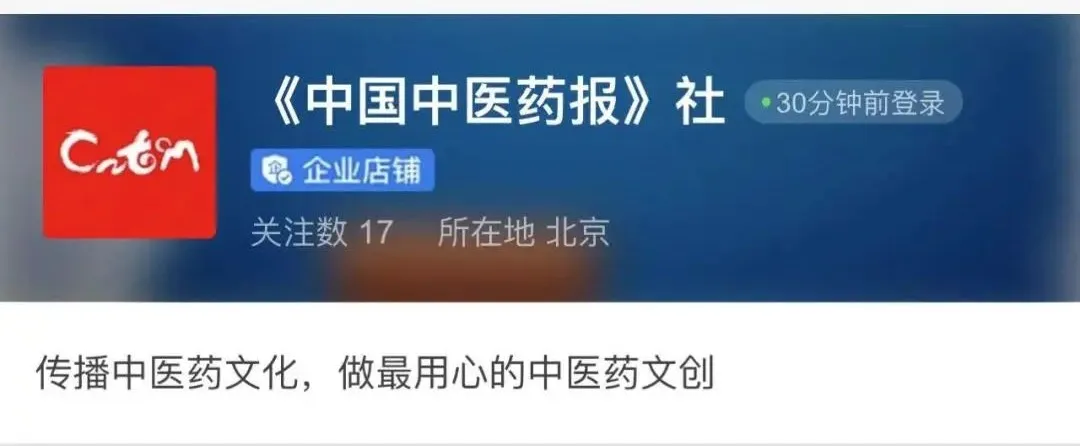
Welcome to follow us!!
“China Traditional Chinese Medicine Newspaper” Douyin Account: 36254766218
Editor|Xu Jing
Review|Li Xiuyun Huang Bei


